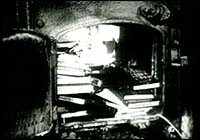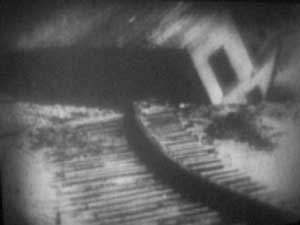|
|
|
|
April
25, Thursday, 8PM, 2002
Appropriated
Images |
|
The Film of Her 12min, 16mm, 1996
Director:
Bill Morrison
 |
A
combination of documentary, fiction, and "found"
footage tells the story of a Library of Congress clerk
who, in 1939, saves an ancient film collection from
incineration.
Award-winning filmmaker Bill Morrison has
shown his collected works in solo shows at New York's
Museum of Modern Art, London's Institute of Contemporary
Art, and Buenos Aires' Museo de Bellas Artes, among
others. Four of his titles are in the permanent collection
of the Museum of Modern Art: "Night Highway"
(1990), "Footprints" (1992), "The Death
Train" (1993), and "The Film of Her"
(1996). "The Film of Her" won numerous awards
at film festivals worldwide, and is also in the collections
of Anthology Film Archives, the Nederlands Filmmuseum
and The New York Public Library. "The Death Train"
was awarded a Dance Theater Workshop"Bessie"
award for excellence in theatrical design, and was
included in the Whitney Museum's survey "The
American Century: Film and Video 1950-2000".
His most recent title, "Ghost Trip" (2000),
was awarded the Jurors' Choice at the Black Maria
Festival. Morrison recently won an Obie award for
his filmwork in the Ridge Theater production of Mac
Wellman's "Jennie Richee". He was awarded
a Guggenheim fellowship for filmmaking in 2000, and
received grants from NYFA and Creative Capital in
2001.
"I started to see that the Film of Her
was the composite, like the opus of what all these
things [shorts] were leading to. But, intellectually,
it's going back to the roots..." - Bill Morrison
http://desires.com/features/thefilmofher/her_interview.html
The Shanghaied Text 20min, 16mm, 1996
Director: Ken Kobland
A
collage of appropriated images from Dziga Vertov’s
3 Songs of Lenin, Alexander Dovzhenko’s Earth,
and Fred Zinnemann’s High Noon, together with
a piece of erotica and Parisian newsreel footage
from 1968, The Shanghaied Text is a frantically
paced, highly visual dance macabre meant to challenge
the expectations of the television-viewing audience.
This manic anti-narrative encapsulates the civic
and sexual passion of colonialization and revolution.
The Shanghaied Text was screened at New York
Video Festival, VideoArt-Karlsruhe, Germany, Media
Biennial-Warsaw, 8th International Video Week-Geneva,
The Rotterdam Film Festival, San Francisco Film
Festival, and BlackMaria Festival. It won awards
at Three-Rivers Film /Video Festival and at Ann
Arbor Film festival.
"Since
the 1970s, Ken Kobland has maintained a distinguished
career as a commercial cinematographer, award-winning
experimental and documentary director in film and
video, and teacher. In addition to his personal
oeuvre of works, he has collaborated on projects
for theatrical presentation with such art-world
notables as Spaulding Gray, Philip Glass, and the
New York City–based experimental theater ensemble
The Wooster Group. He has also directed the cinematography
for a range of television and theatrical works on
visual artists, including Joan Mitchell, Louise
Bourgeois, and Chuck Close (for which he was nominated
for an Emmy). Among his most recent projects is
a series of artists’ portraits made for public
television’s “ART 21.” Trained in
art, architecture, and philosophy, Kobland brings
an acute sense of space and its meanings to works
of unusual lyricism that explore the urban environment."
- Harvard Film Archive
For
more information about the films by Ken Kobland,
visit http://www.kenkoblandfilms.com
Dark
Dark 16min, 2001
Director: Abigail Child
"A gruesome ghost dance of the narrative gesture,
in which four story fragments are combined: film noir,
western, romance and pursuit.
Dark
Dark is an uncanny ghost dance of narrative
gesture blending four found story fragments: Noir,
Western, Romance and Chase. The music of Ennio Morricone
provocatively interacts with the images, tantalizing
the audience with webs of memory, meaning and elusive
folly. This film is a work of subtraction, repositioning
celluloid into a funny and haunting, strangely poignant
world. It creates a vortex of reflexive cinema materialised
in upside-down and backwards footage." - Rotterdam
Film Festival
Abigail
Child is a film and video maker whose montage
pushes the envelope of form and content with smarts
and passion. Her work in the 80s explores gender
while focusing on strategies for rewriting narrative,
while her recent 90s productions recuperate documentary
to poetically explore public space, whether the
homeless of Lower Manhattan or Petersburg, Russia
after Perestroika. * She has exhibited her award-winning
art extensively in both solo and group shows, including
most recently:The American Century, 1950-2000, the
Whitney Biennial (1989 + 97), the New York Film
Festival & Video Side Bar (1989 + 1993), and in
Europe- (London , Rotterdam, Torino, Vienna, Pesaro..).
She is author of five books of poetry (A Motive
for Mayhem, Mob and Scatter Matrix ). and her films
and videos have received many honors including:
an ITVS Screenwriting Grant, Guggenheim Foundation
and Fulbright Fellowships, NYFA, NYSCA, & NEA Interarts
Grants, Jerome and Ludwig Vogelstein Foundation
Grants, Massachusetts Arts Council New Works and
Creative Artists Public Service Awards. Her films
are in the permanent collection of MOMA, New York
and the Centre Pompidou, Paris, among others. *
Child was an undergraduate at Harvard and is senior
Faculty in Film at the Museum School of Fine Arts
in Boston.
Going
Back Home 1min, 35mm (shown on 16mm), 2000
Fissures 2.5min, 16mm, 1999
Director:
Louise Bourque

still from Going Back Home |
Fissures.
A film about forgetting and remembering, about past
presences and the traces they leave. In making this
piece, I literally manipulated and distorted the film
plane through experimentation in doing my own contact
printing of personal home movie images. The point
of contact is continuously shifted so that the film
plane appears warped and the images fluctuate, creating
a distorted space of fleeting apparitions, like resurfacing
memories. The footage was hand-processed and solorized
as well as colored by hand through toning before a
final print was made at the lab.
Going
Back Home: the turmoil of an unsheltered childhood,
which has hidden itself deep inside.
Louise
Bourque is a Canadian experimental filmmaker
living in the Boston area where she is currently
teaching cinema at Emerson College and has been
Visiting Film Faculty at The School of the Museum
of Fine Arts since 1996. Her films have been widely
presented in festivals worldwide and she has received
numerous grants, honors and awards for her work.
The
Morphology of Desire 6min, 16mm, 1998
Director:
Robert F. Arnold
An
experimental exploration of the commodified representation
of romantic love in popular culture, and the relationship
between the still and moving image, using digital
image morphing to animate romance novel cover illustrations
as a dance of unrealized desire. This cyclical movement
is segmented into a minimalist narrative by short
passages quoted from romance novels.
Robert Arnold: Studied sculpture before starting
to make films in 1980. Earned Ph.D. in Film Theory
, University of Iowa, 1994, and has published several
articles in academic film journals. Teaching film
and video since 1985. Currently Associate Professor
of Film Production at Boston University and recently
Visiting Professor of video and installation at the
Academy of Fine Arts in Poznan', Poland. Recipient
of 2001 South Florida Cultural Consortium Fellowship
for Visual and Media Artists. Resides in Jamaica Plain,
MA, with spouse Katie Travis and dogs, Mr. Dog and
Stinky.
License
to Kill, 2min, video, 2001
Director: Sarina Khan Reddy
This
single channel video questions how Pop culture perpetuates
colonialists values of created notions of "civilized"
through the glorification of violence. This piece
uses a James Bond theme song and couples it with graphic
footage of a constructed colonialist scene of a massacre
of unarmed civilians who are non-white and wearing
turbans. In a historical context it starts to question
how these past events have contributed to events of
today.
Sarina
Khan Reddy's video work explores the differences
within her cultural identity as an Islamic-American
woman. Through the lens of her Indian heritage,
she explores the new colonization embodied in globalization.
Specifically she focuses on how the economic system
is reflected in all social formations and how war
and militarization are fueled by corporate globalization.
In her latest work she is exploring the blurred
boundaries between news and entertainment. She uses
appropriated footage from advertising, news, and
Hollywood movies. She juxtaposes these sources to
subvert the original meaning to create new and alternative
histories. She has worked for many years with technology
and today strives towards the strategic use of technology
and media for social change through volunteer work
with local organizations. She has exhibited locally
and nationally.
Untitled
7min, video
Director: Arnold Johnson
Arnold
Johnson began video work in 1984 utilizing film
and miscellaneous TV imagery combined with psychedelic,
minimalist, and verbal audio sources. He created
works both narrative and, influenced by John Cage,
in random form. In 1999, Arnold began to experiment
with Hollywood musicals and other dance footage
combining it with techno and club music. His works
were featured in the Boston Underground Film and
Video Festival 2002.
Meat
Probe 3min, 16mm
Director: Shawn P. Morrissey
A
re-constructed look at the hidden sexuality of Hollywood
action movies. Optically printed, re-pasted footage
from an anonymous 70's B-stunt film, set to altered
sounds from the Die Hard trilogy. Shawn Morrissey
is a graduate from the Mass College of Art and
has worked at the Museum School of the Museum of
Fine Arts and Harvard University. Automatic Meat
Probe has Shown at the New York, Chicago, and Boston
Underground Film Festivals, Cinematexas Film Festival,
Thesseloniki Film Festival, Humboldt Short Film
Festival, the San Francisco Inst. of Contemporary
Art, and has won honorable mentions at the Ann Arbor
Film Festival and Black Maria Film Festival.
|
|
|
 |
|
|
